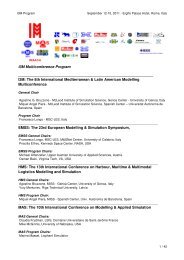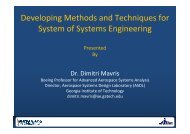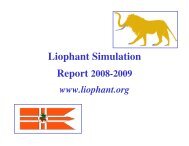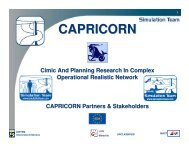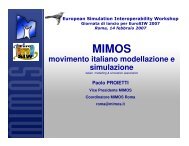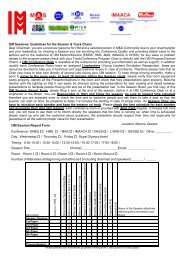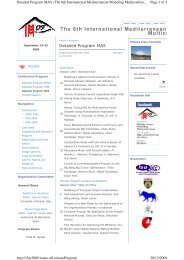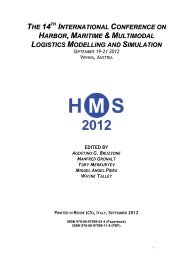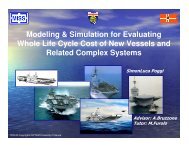HMS2006_F1 - Liophant Simulation
HMS2006_F1 - Liophant Simulation
HMS2006_F1 - Liophant Simulation
Create successful ePaper yourself
Turn your PDF publications into a flip-book with our unique Google optimized e-Paper software.
presented and, more specifically, how the dry<br />
port at study works.<br />
In section 3, the simulation model is described<br />
as well as the performance indicators/measures<br />
selected to assess the different scenarios.<br />
Following, in section 4, the experimentation<br />
conducted is summarised. Finally, section 5<br />
contains the main conclusions of the work.<br />
2. The dry port. Study objectives<br />
The relevance of dry ports is highlighted within<br />
an environment where intermodality is<br />
becoming an ever more public concern.<br />
Since the objective of a more sustainable<br />
development is closely related to transferring<br />
transport from the road to other means of<br />
transport, the interconnection of all available<br />
means is of paramount importance. But<br />
important though it may be, and despite<br />
governments and the Administration support,<br />
combined transport entails difficulties, such as<br />
coordination, which may account for its<br />
sluggish development.<br />
A dry port is a type of intermodal inland<br />
terminal, which is connected to one or more<br />
maritime terminals, with the capability of<br />
postponing customs control at the entry of its<br />
facilities. This feature speeds up freight<br />
delivery from ports towards their destination<br />
points.<br />
Spain has only recently included dry ports in its<br />
network and during the last few years several<br />
projects have been launched all over the<br />
country. Among them, the dry port in Coslada<br />
(Madrid), which has been working for some<br />
years now, is of high strategic value. Actually,<br />
railway combined transport has soared lately<br />
and in a country with the geographic<br />
characteristics of Spain, the maritime ports<br />
become key nodes for international freight<br />
exchange.<br />
The main reason to choose this dry port is the<br />
fact that it is a representative instance of this<br />
type of facilities.<br />
Besides, the dry port in Coslada (located on the<br />
outskirts of Madrid) has a strategic localization<br />
within the Spanish network (in the geographical<br />
centre of the Peninsula) and the high<br />
transportation needs of the region render this<br />
port a very appropriate and interesting case of<br />
study.<br />
Finally, the physical proximity and the<br />
forthcoming attitude of the managers of the dry<br />
port, willing to cooperate and facilitate the<br />
necessary data were additional factors<br />
supporting this election.<br />
The available resources involved in the<br />
operation of the terminal are the following<br />
ones:<br />
• A gantry crane, to load and unload<br />
trains, and reachstackers, mainly to<br />
move containers from the<br />
loading/unloading area to the storage<br />
area and vice versa.<br />
• A yard engine, which moves trains<br />
inside the terminal.<br />
• Tracks for reception and departure, and<br />
tracks for loading and unloading the<br />
trains.<br />
• Storage areas for containers and short<br />
term storage areas located by the<br />
loading and unloading rails.<br />
• Container consolidation/deconsolidation<br />
centre.<br />
With regard to the human resources, personnel<br />
working in the dry port belong either to a work<br />
team from RENFE (the Spanish railway<br />
company) or to a work team from the very<br />
terminal.<br />
For the purpose of the study only 20 and 40 feet<br />
containers were considered.<br />
First of all, although there exist units of<br />
transportation other than containters (such as<br />
swap bodies), most wares are stored in<br />
containers. And, secondly, although several<br />
sizes are available, most of them are either 20<br />
feet or 40 feet.<br />
RENFE owns the rolling stock in the dry port<br />
(the carrier wagons and the engines), and is also<br />
responsible for the management of these assets,<br />
which poses an additional constraint to the<br />
operation of the dry port, since some decisions<br />
are beyond the control of the managers in<br />
Coslada.



